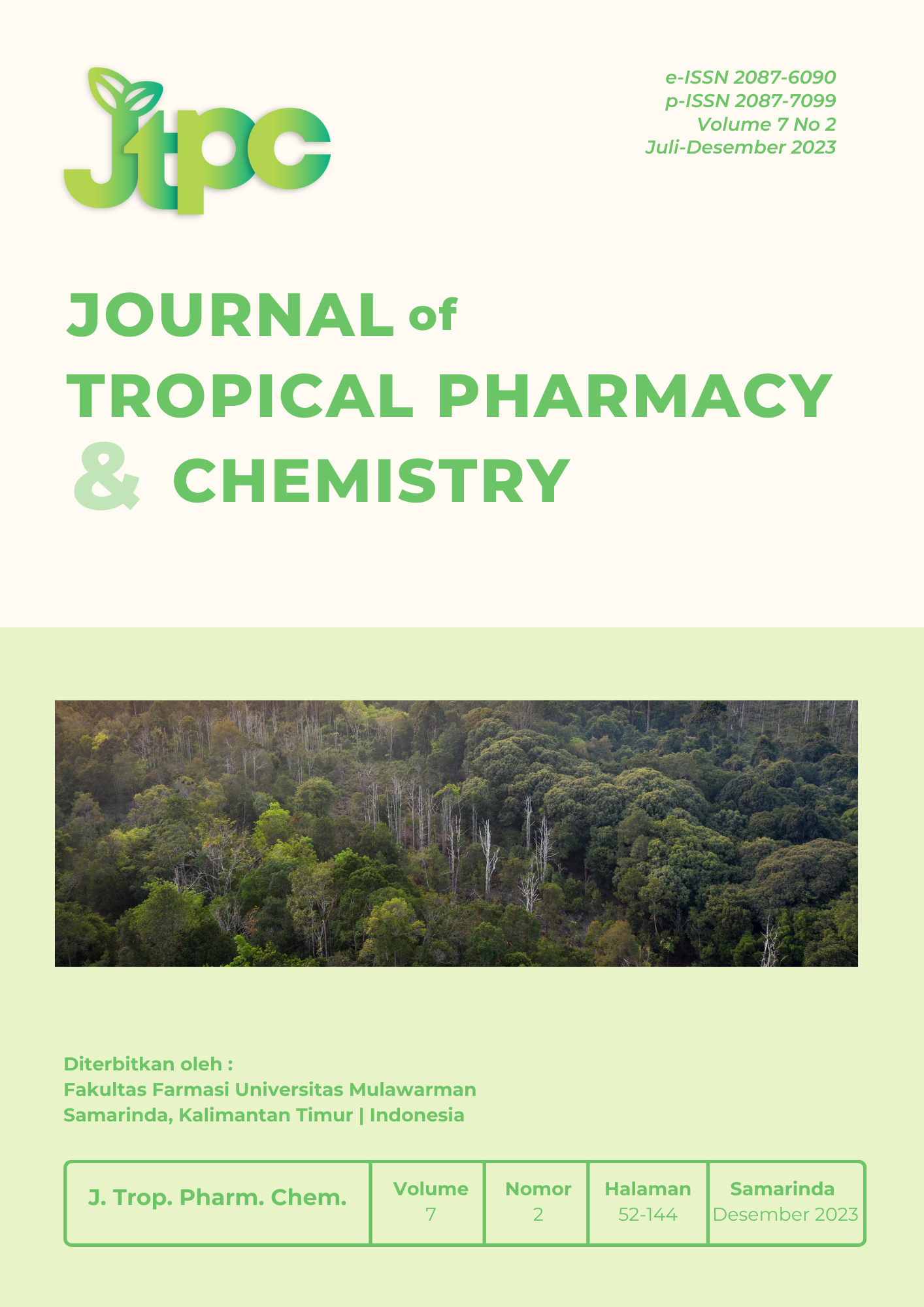Formulation of Silver Nanoparticle Mouthwash and Testing of Antibacterial Activity Against Staphylococcus aureus
DOI:
https://doi.org/10.30872/j.trop.pharm.chem.v7i2.150Keywords:
nanoparticles, nanosilver, mouthwash, antibacterial, Staphylococcus aureusAbstract
Silver Nanoparticles (AgNP) are silver particles of no more than 100 nm in size. Silver nanoparticles have antimicrobial characteristics and have been applied to various fields as antibacterial agents. This study aims to formulate and examine the antibacterial activity in preparing silver nanoparticle mouthwash on Staphylococcus aureus. The silver nanoparticles are synthesized using a chemical reduction method, of which the wavelength is then characterized using UV-Vis spectrophotometry, and the PSA instrument is used for particle size. Silver nanoparticles are formulated for a mouthwash with various concentrations such as 0%, 60%, 70%, and 80% consecutively as formula 1, 2, 3, and 4. The observation is then performed on the organoleptic, pH, stability, and bacterial activity of the Staphylococcus aureus using the disk diffusion method. The study results indicate that the preparation of silver nanoparticle mouthwash has a good organoleptic; the average pH of formula 1, 2, 3, and 4 consecutively is 3.40, 3.40, 3.46, and 3.54; however, it is not stable during the storage stage. The result of the antibacterial activity test on Staphylococcus aureus bacteria shows that formula 2 has the most oversized average inhibition zone diameter that is 13.14±0.31 mm compared to formulas 1, 3, and 4, namely 5.20±0.44; 12.40±0.74; and 8.40±0.89 mm. The active formula of mouthwash preparation to inhibit the growth of Staphylococcus aureus bacteria is formula 2.
Downloads
References
Sinyie, N. M. D. P dan Djitowiyono, S. 2012. Pengaruh Pemberian Getah Jatropha Curcas Linn Terhadap Penyembuhan Luka Pada Stomatitis Aftosa Rekuren Di Wilayah Kerja Puskesmas Kerambitan I Tabanan Bali. Jurnal Ilmu-Ilmu Kesehatan, Vol 8(2), 125.
Lewis, M.A.O dan Lamey, P. J. 2012. Tinjaun Klinis Penyakit Mulut. Jakarta, Indonesia. Widya Medika.
Aulia, A dan Thihana, M. 2007. Potensi Ekstrak Kayu Ulin (Eusideroxylon Zwageri T Et B) dalam Menghambat Pertumbuhan Bakteri Staphylococcus aureus Secara In Vitro. Bioscientiae, Vol 4(1), 37-42.
Rieuwpassa, I. E dan Megasari, D. 2012. Uji Daya Hambat Kandungan Perak Terhadap Pertumbuhan S. aureus. Makasar Dental Journal, Vol 1(6), 1-4.
Minasari., Sri, A dan Sinurat, J. 2016. Efektivitas Ekstrak Daun Jambu Biji Buah Putih Terhadap Pertumbuhan Staphylococcus aureus dari Abses. Makassar Dent Journal, Vol 5(2), 34-39.
Naber, C. K. Staphylococcus Aureus Bacteremia: Epidemiology, Pathophysiology, and Management Strategies. Clinical Infectious Diseases, Vol 48 (4), 231-237.
Causon, R.A., Odell, E.W dan Porter, S. 2002. Causons Essentials of Oral Pathology and Oral Medicine.7th ed. Edinburgh: Churchill Livingstone, 192-193.
Notohartojo, A., Lely, A. M. W dan Olwin. 2011. Nilai Karies Gigi Pada Karyawan Kawasan Industri di Pulo Gadung Jakarta. Media Litbang Kesehatan, Vol 21(4), 166-175.
Ariyanta, H. A., Wahyuni, S dan Priatmoko, S. 2014. Preparasi Nanopartikel Perak dengan Metode Reduksi dan Aplikasinya sebagai Antibakteri Penyebab Infeksi. J Chem Sci, Vol 3(1), 1-6.
Aulia, A dan Thihana, M. 2007. Potensi Ekstrak Kayu Ulin (Eusideroxylon Zwageri T Et B) dalam Menghambat Pertumbuhan Bakteri Staphylococcus aureus Secara In Vitro. Bioscientiae, Vol 4 (1), 37-42.
Saputra, A.H., Agus, H; Joddy, A.L dan M. Hilman Anshari. 2011. Preparasi Koloid Nanosilver dengan Berbagai Jenis Reduktor Sebagai Bahan Anti Bakteri. Jurnal SainsMateri Indonesia, Vol 12 (3), 202-208.
Heydaryinia, A., Veissi, Masoud MSc dan Ali S. M. D. 2011. A Comparative Study of the Effect of the Two Preservatives, Sodium Benzoate and Potassium Sorbate, on Aspergillus niger and Penicillium notatum. Jundishapur Journal of Microbiology, Vol 4 (4), 301-306.
Tran, Quay Huy; Van Quy Nguyen dan Anh-Tuan Le. 2013. Silver Nanoparticles: Synthesis, Properties, Toxicology, Applications and Perspectives. Adv. Nat. Sci.: Nanoscience- Nanotechnology Journal, Vol. 4 (1).
Liu, R. 2018. Water Insoluble Drug Formation Third Edition. US. CRC Press
Apriandanu, DOB., Wahyuni, S., S Hadisaputro., Arjono. Sintesis Nanopartikel Perak Menggunakan Metode Poliol dengan Agen Stabilitator Polivinilalkohol (PVA). 2012, Jurnal MIPA, Vol 36 (2).
Pongsavee, M. 2015. Effect of Sodium Benzoate Preservative on Micronucleus Induction, Chromosome Break, and Ala 40Thr Superoxide Dismutase Gene Mutation in Lymphocytes. BioMed Research International, Vol 20 (15), 1-5.
Sirajudin, A dan Rahmanisa, A. 2016. Nanopartikel Perak sebagai Penatalaksanaan Penyakit Infeksi Saluran Kemih. Majority, Vol 5 (4), 5.
Rieuwpassa, I. E dan Megasari, D. 2012. Uji Daya Hambat Kandungan Perak Terhadap Pertumbuhan Staphylococcus aureus. Makasar Dental Journal. Vol 1 (6), 1-4.
Rowe, R. C., Sheskey, P. J., and Owen, S. C. 2006. Handbook of Pharmaceutical Excipients, fifth edition. London: The Pharmaceutical Press.
Heydaryinia, A., Veissi, Masoud MSc dan Ali S. M. D. 2011. A Comparative Study of the Effect of the Two Preservatives, Sodium Benzoate and Potassium Sorbate, on Aspergillus niger and Penicillium notatum. Jundishapur Journal of Microbiology. Vol 4 (4), 301-306.
Downloads
Published
Issue
Section
License
Copyright (c) 2025 Rahmi Annisa, Begum Fauziyah, Dewi Sinta Megawati, Firdausi Zahrah (Author)

This work is licensed under a Creative Commons Attribution-NonCommercial 4.0 International License.




